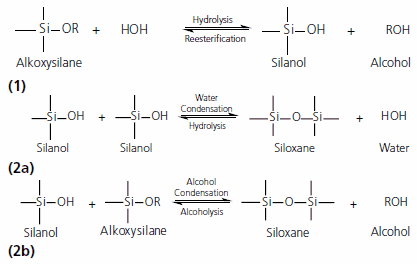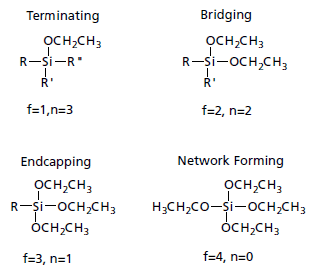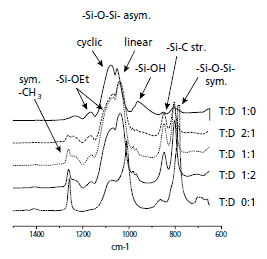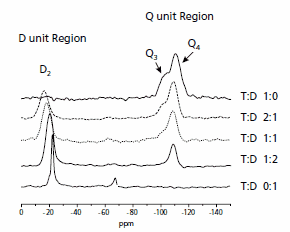陶瓷材料溶胶-凝胶学
Dr. Sandra Kay Young,
Material Matters 2006, 1.3, 8.
简介
近年来,以硅为基础的研究引起了不少关注,例如国际溶胶-凝胶协会等相关组织主办了许多研讨会,1以及Sol-Gel Gateway2发布了有关溶胶-凝胶领域的信息概要,包括会议信息。此外,同行评议的期刊,如《溶胶-凝胶科学与技术杂志》、《材料化学》、《非晶固体杂志》等,也发表了大量以硅为基础材料的文章。这些组织、会议和期刊着重介绍了来自学术界和行业基于硅的主要研究。涉及到反应性有机硅化学的研究已聚焦于纯硅和杂合材料的生产、氢化硅烷化、开环和原子转移聚合,以及具有受控立体化学的聚合和缩合反应。与硅酮的反应产生了广泛的材料,它们涵盖了硅化学的主要领域:聚合物、弹性体陶瓷、互穿网络、增强填料、膜、微光刻、光引发、高性能聚合物和溶胶-凝胶衍生的陶瓷前体。
虽然问世较早,但溶胶-凝胶化学从20世纪70年代中期起就得到了广泛的研究,当时溶胶-凝胶反应被证明可以由金属醇氧溶液形成多种无机网络。3 通过溶胶-凝胶处理,可以在环境温度下而不是在传统方法所要求的非常高的温度下制备均匀、高纯度的无机氧化物玻璃。各种产品,如模制凝胶、4,5纺成纤维、6,7薄膜、8-10分子笼、11,12和干凝胶13已开发用于气体分离、弹性体、涂料和层压板等领域。正是通过无机组分与有机聚合物的结合,才能实现各种理想的性能改性。
溶胶-凝胶处理中使用的前体由金属或由各种活性配体包围的非金属元素组成。金属烷氧化物,如铝酸盐、钛酸盐和锆酸盐,由于其对水的高反应性,是最常用的前体。应用最广泛的非金属烷氧化合物是烷氧基硅烷,如四甲基硅烷(TMOS,货号679259) 和四乙氧基硅烷(TEOS,货号333859)。虽然乙基是最常见的烷氧基,但甲氧基、丙氧基、丁氧基等长链烃烷氧基也用于烷氧硅烷中。金属烷氧化合物通常单独或与非金属烷氧化合物如TEOS或烷氧基硼酸盐结合使用在溶胶-凝胶处理中。
溶胶-凝胶
溶胶-凝胶过程由一系列醇氧化合物的水解和缩合反应组成,按照 图1的反应流程反应。此处以烷氧基硅烷为例,但所有的金属烷氧化合物的反应都是类似的。水解是通过在酸性、中性或碱性条件下向硅烷溶液中加入水而开始的。

图 1.溶胶-凝胶反应流程。
由于反应速度极快,大多数金属醇氧化合物的水解和缩合反应可以在没有催化剂的情况下进行,而醇氧硅烷的水解速度要慢得多,需要添加酸性或碱性催化剂。为了减缓金属烷氧化物的反应动力学,常采用干燥化学控制添加剂(DCCA)。14,15 这些包括四氢呋喃、甲酰胺、二甲基甲酰胺和草酸。DCCAs通过与反应中的中间体形成氢键来减慢反应动力学。DCCA溶剂可通过蒸发去除,而使反应进行。
优势和应用
溶胶-凝胶处理有利于陶瓷和玻璃薄膜的形成,原因有很多。这是一个简单的反应,不需要外来的材料,催化剂或昂贵的镀膜设备。同样,溶胶-凝胶反应也不需要极端的反应条件。该反应在室温下进行,只需要中等温度就可以“固化”凝胶,去除反应生成的水/酒精。利用有机改性的醇氧化合物或可变臂类金属(例如,用醇氧硼酸盐代替烷氧硅烷),用溶胶法制备的材料的性质很容易被改变。
溶胶-凝胶法是对S2玻璃纤维(一种高性能玻璃纤维)进行改性的常用方法。在玻璃表面涂上一层溶胶-凝胶膜可以帮助玻璃获得强度并抵抗粉碎。而且,溶胶-凝胶材料已用于复合材料中,以加强现有的聚合物结构,如聚酯、16 Nafion®、17 Surlyn®。18 在所有这些应用中,溶胶-凝胶烷氧基硅烷和烷氧基钛酸盐的纯度均为97%或更高。
修饰溶胶-凝胶网络
一种方便的方法对陶瓷和如前段所述复合材料进行改性,是应用有机改性硅酸盐(ORMOSILs)。ORMOSILs是从四功能化合物的硅醇盐衍生得到,如TEOS,如图2所示,其中n代表连接到硅原子上的有机基团的数量而f代表连接到硅上的反应烷氧基的数量。R, R’, 和 R” 是有机改性硅酸盐(如甲基、乙烯基或苄基)上的官能团。通常,有机部分包括一个反应基团,如胺或环氧化合物,这使得后续反应成为可能。

图 2.ORMOSILs的功能
硅倍体是陶瓷和复合材料中广泛应用的另一无机-有机改性剂。(图3)所示的桥接倍半硅氧烷包括一种取代基 (R),该取代基是烃基,但也可以包含有机间隔官能团。由于硅倍氧烷经常被纳入聚合物体系中,因此R-基团应该尽可能地与重复单元相似,从而提高界面相容性。

图 3.6-臂和4-臂桥接的硅倍半氧烷的例子。
此外,许多笼状结构正通过溶胶-凝胶化学反应被引入陶瓷和复合材料中。这些结构,如多面体硅氧烷19,20(也称为 PSS)或沸石,21为材料增加了一定的孔隙度和硬度。笼状结构可以通过非共价键(将材料困在陶瓷结构内)或共价键结合。
研究溶胶-凝胶网络
陶瓷和复合材料结构中的溶胶-凝胶键合经常通过FTIR和固态NMR(例如29Si MAS NMR)进行研究。通过对块状材料的XPS表面和瞬发γ中子活化分析可以确定其元素比率。图4表示了四乙硅酸盐溶胶-凝胶ORMOSIL (T)的FT-IR数据:二乙氧基二甲基硅烷(D)溶胶-凝胶在描绘的不同的硅键结构的全氟磺酸结构中聚合。22 明显的光吸收是由于非对称Si-O-Si被膜引起,由环状(~1080 cm-1)和线性(~1030 cm-1)组成。

图 4.四乙硅酸盐(T)的FT-IR ATR差分光谱:二乙氧基二甲基硅烷(D)溶胶-凝胶在全氟磺酸结构中聚合。22

图 5.显示了从ORMSIL四乙硅酸盐/二乙氧基二甲基硅烷在描绘的不同的硅键结构的全氟磺酸结构中聚合的固态的29Si MAS NMR数据。
结论
溶胶-凝胶科学技术有潜力对材料的改性产生重大影响。溶胶-凝胶科学最显著的优势之一是它利用了室温条件和对环境的不敏感性。这些特性将允许它与各种耐高温的材料一起使用,并且不限制研究人员使用特殊设备,如干燥盒。
产品列表
参考文献
如要继续阅读,请登录或创建帐户。
暂无帐户?